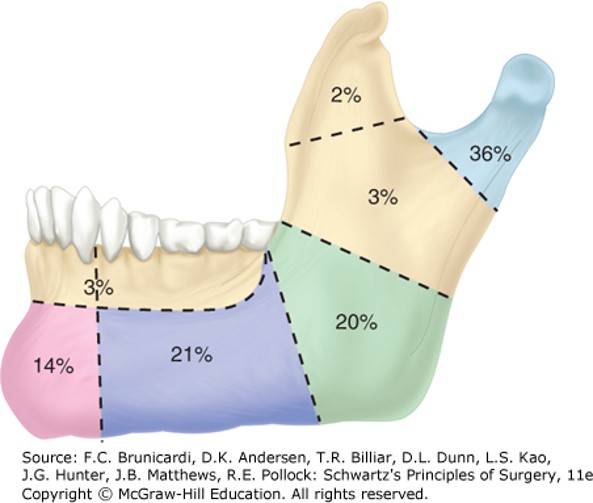
The plurality of facial fractures is induced by motor vehicle accidents or aggravated assault; 50 to 70% of patients with facial fractures/injuries will have accompanying injuries. These patients must be subjected to comprehensive evaluation by a multidisciplinary team. Often the facial fracture is not a life-threatening emergency but the concomitant injuries can be critical or fatal to the trauma patient. Therefore, a coordinated team of multiple specialties must examine and monitor the patient and provide adequate resuscitation and treatment. Maxillofacial fractures can be divided into three categories: emergency, delayed, or early.
Emergency treatment for life-threatening facial fractures includes respiratory obstruction, aspiration, and hemorrhage. Pulmonary obstruction or aspiration can ensue as a consequence of complications from combined maxillary, mandibular, and nasal fractures, unstable comminuted mandible fractures with loss of tongue support, and bleeding in the presence of soft-tissue edema. In these circumstances, emergent nasal or general endotracheal intubation may be instituted if there is trepidation in future airway management. Tracheostomy or cricothyroidotomy as an emergent airway can be entertained in the setting of a head-injured patient who requires intermaxillary fixation, spastic head-injured patients, panfacial fractures, comminuted nasal and maxillary fractures with unstable occlusion, and patients with pulmonary injury who require intermaxillary fixation.
After a systems evaluation has been completed and the patient is stabilized, the plastic surgeon must perform a thorough physical and radiographic examination. Facial injuries/fractures should be suspected in individuals with contusions, pain or localized tenderness, lacerations, numbness, paralysis, malocclusion, visual disturbances, and facial asymmetry. Nevertheless, examination of the face should be carried out in an orderly, concise manner, proceeding from either superior to inferior or inferior to superior and should entail:
- Evaluation for asymmetry and deformity.
- Palpation of entire craniofacial skeleton (orbital rims, nose, zygomatic arch, midface stability, mandible to detect any irregularities or crepitation).
- Investigation of facial nerve function on both sides.
- Evaluation of facial sensation regarding supratrochlear, supraorbital, infraorbital, and infra-alveolar nerve distribution.
- Intranasal inspection for septal hematoma.
- Ophthalmologic examination for any potential extraocular entrapment or optic nerve deficit.
- Malocclusion: excursion of jaw, the relationship of teeth during occlusion, detection of abnormal intercuspation, fractured or missing teeth, dislocation of the condyle from the glenoid fossa.

Figure legend: Sites of common mandible fractures. Disorders of the Head and Neck, Brunicardi F, Andersen DK, Billiar TR, Dunn DL, Kao LS, Hunter JG, Matthews JB, Pollock RE. Schwartz's Principles of Surgery, 11e; 2019.
Board Review Questions
1. A 25-year-old male is thrown from his motorbike and his chin hits first against a concrete sidewalk. A panorex x-ray indicates a symphyseal fracture of the mandible. You note that he is unable to close his mouth at all. What other injury has the patient most likely suffered?
A. unilateral subcondylar/condylar fracture
B. bilateral subcondylar or condylar fractures
C. rupture of pterygoid muscle tendon attachments to pterygoid plates
D. a ramus fracture
E. a contralateral body fracture
2. Le Fort II fracture entails injuries to all of the following EXCEPT
A. Medial wall of the orbit
B. Alveolus
C. Zygomaticomaxillary articulation
D. Nasofrontal buttress
E. Mandible
3. The most common area of the mandible to be fractured is the
A. Condyle
B. Ramus
C. Angle
D. Body
Answers
1. The correct answer is B. bilateral subcondylar or condylar fractures
2. The correct answer is E. Mandible
3. The correct answer is A. Condyle

Create a Free MyAccess Profile
AccessMedicine Network is the place to keep up on new releases for the Access products, get short form didactic content, read up on practice impacting highlights, and watch video featuring authors of your favorite books in medicine. Create a MyAccess profile and follow our contributors to stay informed via email updates.